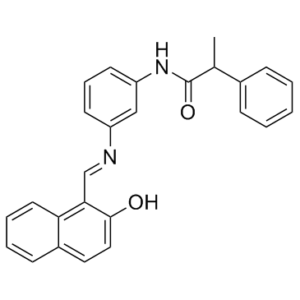Salermide
This product is for research use only, not for human use. We do not sell to patients.

For small sizes, please check our retail website as below: www.invivochem.com
| Size | Price | Stock |
|---|---|---|
| 250mg | $700 | Check With Us |
| 500mg | $1150 | Check With Us |
| 1g | $1725 | Check With Us |
Cat #: V3246 CAS #: 1105698-15-4 Purity ≥ 98%
Description: Salermide is a potent inhibitor of Sirt1/2 (Sirtuin 1/2) with a strong cancer-specific proapoptotic effect mediated by Sirt1.
Top Publications Citing Invivochem Products
Publications Citing InvivoChem Products
Product Promise

- Physicochemical and Storage Information
- Protocol
- Related Biological Data
- Stock Solution Preparation
- Quality Control Documentation
| Molecular Weight (MW) | 394.47 |
|---|---|
| Molecular Formula | C26H22N2O2 |
| CAS No. | 1105698-15-4 |
| Storage | -20℃ for 3 years in powder formr |
| -80℃ for 2 years in solvent | |
| Solubility In Vitro | DMSO: 10 mMr |
| Water: N/Ar | |
| Ethanol: N/A | |
| SMILES Code | O=C(NC1=CC=CC(/N=C/C2=C3C=CC=CC3=CC=C2O)=C1)C(C)C4=CC=CC=C4 |
| Synonyms | Salermide |
| Protocol | In Vitro | Salermide shows a dose-dependent inhibition that rises to 80% at 90 μM and 25 μM against Sirt1 and Sirt2, respectively. Salermide can prompt tumour-specific cell death in a wide range of human cancer cell lines derived from leukaemia (MOLT4, KG1A, K562), lymphoma (Raji), colon (SW480) and breast (MDA-MB-231). Incubation with 100 μM Salermide alone resulted in an increase of cytosolicactivated caspase 3 and a decrease of mitochondrialcytochrome. Salermide alone can induce apoptosis through both extrinsic and intrinsic pathways. Salermide had several antitumorigenic advantages over the earlier described class III HDAC inhibitors: firstly, it mimics the universal proapoptotic effect on cancer samples exhibited by the classical class I, II and IV HDAC inhibitors, and secondly, its proapoptotic effect is cancer-specific |
|---|---|---|
| In Vivo | Salermide is well tolerated by mice at concentrations up to 100 μM. Salermide's mechanism of action in vivo is specifically mediated by Sirt1. Intraperitoneal feeding of Salermide has no apparent toxicity in nude mice |
These protocols are for reference only. InvivoChem does not
independently validate these methods.
| Solvent volume to be added | Mass (the weight of a compound) | |||
|---|---|---|---|---|
| Mother liquor concentration | 1mg | 5mg | 10mg | 20mg |
| 1mM | 2.5350 mL | 12.6752 mL | 25.3505 mL | 50.7009 mL |
| 5mM | 0.5070 mL | 2.5350 mL | 5.0701 mL | 10.1402 mL |
| 10mM | 0.2535 mL | 1.2675 mL | 2.5350 mL | 5.0701 mL |
| 20mM | 0.1268 mL | 0.6338 mL | 1.2675 mL | 2.5350 mL |
The molarity calculator equation
Mass(g) = Concentration(mol/L) × Volume(L) × Molecular Weight(g/mol)
Mass
=
Concentration
×
Volume
×
Molecular Weight*
The dilution calculator equation
Concentration(start)
×
Volume(start)
=
Concentration(final)
×
Volume(final)
This equation is commonly abbreviated as: C1 V1 = C2 V2
Concentration(start)
C1
×
Volume(start)
V1
=
Concentration(final)
C2
×
Volume(final)
V2
Step One: Enter information below
Dosage mg/kg
Average weight of animals g
Dosing volume per animal µL
Number of animals
Step Two: Enter the in vivo formulation
%DMSO
+
%
+
%Tween 80
+
%ddH2O
Calculation Results:
Working concentration:
mg/ml;
Method for preparing DMSO master liquid:
mg
drug pre-dissolved in
µL
DMSO(Master liquid concentration
mg/mL)
,Please contact us first if the concentration exceeds the DMSO solubility of the batch of drug.
Method for preparing in vivo formulation:
Take
µL
DMSO master liquid, next add
µL
PEG300, mix and clarify, next add
µL
Tween 80,mix and clarify, next add
µL
ddH2O,mix and clarify.
Note:
- (1) Please be sure that the solution is clear before the addition of next solvent. Dissolution methods like vortex, ultrasound or warming and heat may be used to aid dissolving.
- (2) Be sure to add the solvent(s) in order.




































